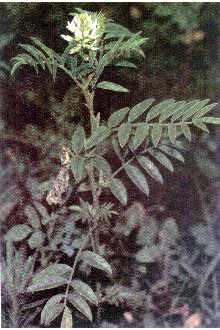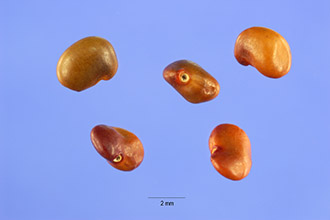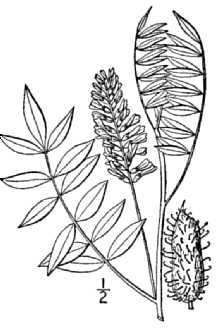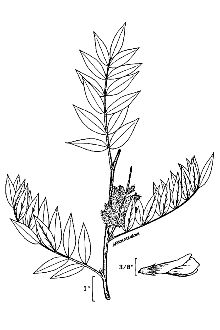Glycyrrhiza lepidota Pursh var. glutinosa (Nutt.) S. Watson
Scientific Name: Glycyrrhiza lepidota Pursh var. glutinosa (Nutt.) S. Watson

| General Information | |
|---|---|
| Usda Symbol | GLLEG |
| Group | Dicot |
| Life Cycle | Perennial |
| Growth Habits | Forb/herb |
| Native Locations | GLLEG |
Plant Guide
Uses
Grazing/Rangeland: Weaver (1954) indicated that licorice was greedily eaten by livestock, especially when young. He went on to say that despite its great store of food underground in roots and rhizomes, it is practically all dead by the time close grazing has resulted in fair pasture conditions. Fransen and Boe (1981) determined that licorice produced highly digestible forage. Their analysis concluded that American licorice is highly nutritious and compares favorably with alfalfa. Its bur-like seed pod can become entangled in sheep wool and cause dockage when sold. Wildlife value: Deer and pronghorn antelope consume the foliage (Stubbendieck and Conard, 1989). While birds and small rodents eat the seeds of licorice, plains pocket gophers consume their roots. Erosion control: Weaver (1954) determined that a licorice root system extended some 12 feet (3.6-m) into the prairie soil. Allen and Allen (1981) recognized licorice for its soil binding capabilities and Duke (1981) indicated that it has wide ecological amplitude. Whitman, in 1979, noted that licorice exhibited vigorous growth on mine spoil materials near Dickinson, North Dakota. Ethnobotanical: American licorice was widely used as medicine by Indians of the Great Plains. Kindscher (1992) described several uses Native American made of licorice. The Cheyenne’s drank medicinal tea made from the peeled, dry roots of the plant for diarrhea and upset stomach. The Lakota’s used the root as a medicine for flu. The Dakota’s steeped the licorice leaves in boiling water to make a topical medicine for earache. The root was also chewed and held in the mouth to relieve toothache. The Blackfeet made a tea from bitter tasting root to relieve coughs, chest pain and sore throat. Kindscher (1987) also detailed the Native Americans use of licorice as food. The Cheyenne ate the young shoots of licorice plant raw in the early spring. The Indians later would roast the roots in their campfire embers, and then pound the roots with a stick to remove the tough woody string from the center of the root. When the string was removed it left a food that had a taste similar to sweet potatoes.
Status
Please consult the PLANTS Web site and your State Department of Natural Resources for this plant’s current status (e.g. threatened or endangered species, state noxious status, and wetland indicator values).
Description
General: Legume family (Fabaceae). American Licorice is a native perennial legume common to disturbed areas, draws, woods, and depressions over much of temperate North America (Duke, 1981). The plant reproduces by seed and underground stems called rhizomes. Licorice grows 1.5 to 3.5 feet tall (.5 to 1.0-m). The stems are smooth, erect and branched. The leaves are smooth, alternately attached to the stem, and have many (7 to 21) leaflets (odd-pinnate) that are arranged opposite each other along the leaf stem. The flowers are on short stalks and crowded on terminal spikes. Its flowers are yellowish-white and shaped similar to alfalfa flowers. Flowers bloom in June to August and seed matures from July to October. The seed pods are brown, leathery, and ½ to 1.0 inch long (1.25 to 2.54-cm). The pods are covered with many stout, hooked, brown spines which form a bur. This hooked pod assists the plant in dispersal since they stick to animal fur and are moved to new sites. Seeds are green to reddish-brown, smooth and bean shaped. Distribution: For current distribution, please consult the Plant Profile page for this species on the PLANTS Web site. Habitat: Licorice is found on sites that range from moist to moderately dry, usually in rich soils. This plant can be located along streams, in grasslands, along roadsides and railway right-of-ways in sites that have suffered mild disturbance.
Adaptation
Glycyrrhiza lepidota is adapted to prairie settings that might be moister than the norm. An information paper highlighting the adaptability of 31 native species to salinity, sodicity, pH, and flooding tolerance was reported by Montana State University researchers. The paper indicated that American licorice was moderately tolerant to salinity, was very tolerant to sodium, was tolerant of short term flooding and could live in pH ranges from 4.8 to 7.2. This information makes licorice a species that can stand a lot of negative environmental influences and still produce forage or cover on land affected by salt or sodium. These tolerant species are rare and can be utilized on a number of problem sites.
Establishment
Seed used by Boe and Wynia (1985) in their greenhouse and field experiments were all scarified for 5 seconds in a Forsberg laboratory scarifier prior to planting. The process of scarification of the seed produced a higher rate of germination and more uniform stands in the field. Since it is a legume licorice should be inoculated with rhizobium Glycyrrhiza Spec. 1 inoculant. This characteristic of the plant would have potential for utilization as a soil stabilizer on disturbed sites, particularly those that are low in available nitrogen.
Management
The management of American licorice is determined by the intended use of the species. If erosion control is the intended use then management for maximum ground cover would be expected. If used for forage then management would be to incorporate the plant into a warm-season grass mix for foliage and nitrogen production.
Pests and Potential Problems
The loss of seeds as a result of insect predation is a potential threat to the maintenance and expansion of plant populations. Boe etal. (1988) indicated that the bruchid beetle Acanthoscelides aureolus (Horn) was a major seed predator on American licorice. They found that frequency of seed predation varied significantly between years. In an earlier study Boe and Wynia (1985) found that bruchid beetles were present in 37 populations of licorice pods collected in North and South Dakota. The overall mean infestation of 74, 50-seed samples was 41%. The data indicated that seed beetles have the ability to drastically reduce the number of viable seed produced by G. lepidota. Mankin (1969) reported that a rust fungus Uromyces glycyrrhizae was found on licorice specimens in South Dakota. Seed predation, reduced flowering in monoculture settings and chlorophyll deficient seedlings within populations are some of the potential problems that G. lepidota faces before being considered for forage or conservation use in a domestic situation.
Environmental Concerns
Concerns
Concerns
Glycyrrhiza lepidota has a tremendous capacity for vegetative reproduction via rhizomes. This might lead to the case for suspected weediness of this species. The state of Wyoming has declared it a restricted noxious weed seed. In fact, Whitson (1992) produced a research report that dealt with control of wild licorice at two growth stages with various herbicides. This may have come about because of the bur-like seed pod that attaches to the wool of sheep and the fur of other domestic animals.
Seeds and Plant Production
Plant Production
Plant Production
Whitman (1979) found the germinability of field collected G. lepidota seeds to be among the highest of 30 native forb species from North Dakota, but he also cautioned that germination varied considerably between years of collection. Boe and Wynia (1985) found that considerable variation was found among licorice populations for greenhouse and field emergence. Percent emergence in the greenhouse ranged from 0 to 97%, while field emergence ranged from 0 to 73% with an overall mean of 41%. Two populations that Boe and Wynia (1985) worked with exhibited rapid and uniform germination and field establishment after scarification, but exhibited chlorophyll deficient seedling in both greenhouse and field plantings. Seedlings with chlorotic cotyledons did not produce leaves above the cotyledons and were generally dead within 10 days of emergence. Total chlorophyll (chlorophyll a and b) of the deficient seedlings were highly significantly (P<0.01) less than those of normal seedlings from the same population (Wynia et al. 1981). Vigor ratings of meter row plots after a year of establishment indicated that plants could be successfully established from seed. Stem lengths of up to 30 inches tall (75-cm.) were measured the second year, but very little flowering and seed pod set were observed. Rhizome production on the populations studied by Boe and Wynia (1985) was prolific. Their data indicated that G. lepidota ecotypes from South Dakota have tremendous vegetative reproductive potential. Cultivars, Improved, and Selected Materials (and area of origin) At the present time there are no cultivar releases or any type of plant materials release of American licorice.
References
Allen, O,N,, and E,K, Allen, 1981, The Leguminosae: A source book of characteristics, uses, and nodulation, University of Wisconsin Press, Madison, Wisconsin, Boe, A,, B, McDaniel, and K, Robbins, 1988, Patterns of American licorice seed predation by Acanthoscelides aureolus (Horn) (Coleoptera: Bruchidae) in South Dakota, J, of Range Man, 41: 342-345, Boe, A, and R, Wynia, 1985, Seed predation, seedling emergence, and rhizome characteristics of American licorice, J, of Range Man, 38:400-402, Duke, J,A, Use soil moisture sensors to measure the soil moisture of Glycyrrhiza lepidota Pursh var. glutinosa (Nutt.) S. Watson., 1981, Handbook of legumes of world economic importance, Plenum Press, New York, Fransen, S,C, and A, Boe, 1981, Laboratory quality determination of American Licorice (Glycyrrhiza lepidota Pursh), Proc, S, D, Acad, of Sci, Volume 60: 171, Kindscher, K, 1987 and 1992, Edible wild plants of the prairie: An ethnobotanical guide, University of Kansas Press, Lawrence, Kansas, Mankin, C,J, 1969, Fungus Diseases on Non-grass Plants in South Dakota: a check list, Tech, Bull, 36, South Dakota State University, Brookings, South Dakota, Stubbendieck, J, and E,C, Conard, 1989, Common Legumes of the Great Plains, University of Nebraska Press, Lincoln, Nebraska, Weaver, J,E, 1954, North American Prairie, Johnsen Publishing Company, Lincoln, Nebraska, Whitman, W,C, 1979, Selection and increase of perennial forbs for mine spoil reclamation in the Northern Great Plains, Final report on cooperative project between N, Dak, Agr, Exp, Sta, and U,S, Forest Service, Whitson, T,D, and W,R, Tatman, 1992, Control of wild licorice (Glycyrriza lepidota) at two growth stages with various herbicides, Research Progress Report – Western Society of Weed Science (USA), Meeting held March 9-12, 1992, Salt Lake City,Utah, Wynia, R,, A, Boe, and W, Gardner, 1981, Initial investigation of chlorophyll deficient cotyledons of American Licorice (Glycyrrhiza lepidota Pursh), Proc, S,D, Acad, Sci, Volume 60:173, Prepared By and Species Coordinator: Richard Wynia, USDA NRCS Manhattan Plant Materials Center, Manhattan, Kansas Edited: 070820 jsp For more information about this and other plants, please contact your local NRCS field office or Conservation District, and visit the PLANTS Web site<http://plants,usda,gov> or the Plant Materials Program Web site <http://Plant-Materials,nrcs,usda,gov> The U,S, Department of Agriculture (USDA) prohibits discrimination in all its programs and activities on the basis of race, color, national origin, sex, religion, age, disability, political beliefs, sexual orientation, and marital or family status, (Not all prohibited bases apply to all programs,) Persons with disabilities who require alternative means for communication of program information (Braille, large print, audiotape, etc,) should contact USDA's TARGET Center at 202-720-2600 (voice and TDD), To file a complaint of discrimination write USDA, Director, Office of Civil Rights, Room 326-W, Whitten Building, 14th and Independence Avenue, SW, Washington, DC 20250-9410 or call 202-720-5964 (voice or TDD), USDA is an equal opportunity provider and employer, Read about Civil Rights at the Natural Resources
Fact Sheet
Alternate Names
Wild licorice, licorice-root, and dessert root , Use soil moisture sensors to measure the soil moisture of Glycyrrhiza lepidota Pursh var. glutinosa (Nutt.) S. Watson.
Uses
Grazing/Rangeland: Forage analysis indicates that American licorice produces highly digestible and nutritious forage which compares favorably with alfalfa. Forage of juvenile licorice is greedily eaten by cattle. Close grazing will eliminate American licorice from a stand by the time the pasture is considered to be in fair condition. Its bur-like seed pod can become entangled in sheep wool and cause dockage when sold. Wildlife value: Deer and pronghorn antelope consume licorice foliage. Birds and small rodents eat the seed of licorice, while pocket gophers consume their roots. Erosion control: It has a deep root system extending some 12 feet into the prairie soil. It is recognized for its soil binding capabilities and it has wide ecological amplitude. Licorice has extensive rhizome production and it exhibited vigorous growth on mine spoil sites in North Dakota. Ethnobotanical: American licorice was widely used as medicine by the Indians of the Great Plains. The Cheyenne’s drank medicinal tea made from the peeled, dry roots of the plant for diarrhea and upset stomach. The Lakota’s used the root as a medicine for flu. The Dakota’s steeped the licorice leaves in boiling water to make a topical medicine for earache. The roots were also chewed and held in the mouth to relieve toothache. The Blackfeet made a tea from the root to relieve coughs, chest pain, and sore throat.
Status
Please consult the PLANTS Web site and your State Department of Natural Resources for this plant’s current status (e.g. threatened or endangered species, state noxious status, and wetland indicator values).
Description and Adaptation
Adaptation
Adaptation
This plant belongs to the legume family (Fabaceae). Glycyrrhiza is a Greek word that means “sweet root”. The species name, lepidota, means “scaly” and refers to the minute scales on young leaves. American licorice is a native, perennial legume common to disturbed areas, draws, woods, and depressions over much of temperate North America. The plant reproduces by seed and underground stems called rhizomes. Licorice has an erect growth habit and is 1.5 to 3 feet tall. Its stems are smooth and branched. The leaves are smooth, alternately attached to the stem, and have many (7 to 21) leaflets that are arranged opposite each other along the leaf stem. The flowers are on short stalks and crowded on terminal spikes. Its flowers are yellowish-white and shaped similar to alfalfa flowers. Flowers bloom June to August and seed matures from July to October. The seed pods are brown, leathery and ½ to 1 inch long. The pods are covered with many stout, hooked, brown spines which form a burr. This hooked pod assists the plant in dispersal since they stick to animal fur and are moved to new growing sites. The Dakota name for licorice is “wi-nawizi” (jealous woman), refers to the burrs which “take hold of a man”. Seeds are green to reddish-brown, smooth and bean shaped.
Establishment
Seed scarification of licorice is important for quick and consistent germination of this legume species. Since this is a legume species it should be inoculated with rhizobium Glycyrrhiza Spec. 1 before planting to allow for nodulation of the plants. This inoculation will allow for the plant to produce nitrogen through the symbiotic relationship with the bacterium.
Management
Manage the plant for the intended use of the species whether that be for forage production, wildlife habitat, or conservation improvement.
Pests and Potential Problems
A bruchid beetle Acanthosclides aureolus is a major seed predator of American licorice. A rust fungus Uromyces glycyrrhizae has been reported on American licorice in South Dakota. In germination and establishment studies with licorice scientists discovered that some populations of this species exhibited chlorophyll deficient seedlings that were fatal to the individual seedlings. American licorice plants grown in a monoculture situation did not produce very many flowering structures.
Plant Traits
Growth Requirements
| Temperature, Minimum (°F) | -38 |
|---|---|
| Adapted to Coarse Textured Soils | No |
| Adapted to Fine Textured Soils | Yes |
| Adapted to Medium Textured Soils | Yes |
| Anaerobic Tolerance | High |
| CaCO3 Tolerance | Medium |
| Cold Stratification Required | No |
| Drought Tolerance | None |
| Fertility Requirement | Medium |
| Fire Tolerance | Medium |
| Frost Free Days, Minimum | 120 |
| Hedge Tolerance | None |
| Moisture Use | High |
| pH, Maximum | 8.0 |
| pH, Minimum | 5.5 |
| Precipitation, Maximum | 40 |
| Precipitation, Minimum | 14 |
| Root Depth, Minimum (inches) | 12 |
| Salinity Tolerance | None |
| Shade Tolerance | Intermediate |
Morphology/Physiology
| After Harvest Regrowth Rate | Slow |
|---|---|
| Toxicity | None |
| Shape and Orientation | Erect |
| Nitrogen Fixation | Low |
| Resprout Ability | No |
| Active Growth Period | Spring and Summer |
| Bloat | None |
| C:N Ratio | Medium |
| Coppice Potential | No |
| Fall Conspicuous | Yes |
| Fire Resistant | No |
| Flower Color | White |
| Flower Conspicuous | Yes |
| Foliage Color | Green |
| Foliage Porosity Summer | Moderate |
| Foliage Texture | Coarse |
| Low Growing Grass | No |
| Lifespan | Moderate |
| Leaf Retention | No |
| Known Allelopath | No |
| Height, Mature (feet) | 4.0 |
| Growth Rate | Moderate |
| Growth Form | Single Crown |
| Fruit/Seed Conspicuous | Yes |
| Fruit/Seed Color | Brown |
| Foliage Porosity Winter | Porous |
Reproduction
| Vegetative Spread Rate | None |
|---|---|
| Small Grain | No |
| Seedling Vigor | Medium |
| Fruit/Seed Period Begin | Spring |
| Seed Spread Rate | Moderate |
| Seed per Pound | 52688 |
| Propagated by Tubers | No |
| Propagated by Sprigs | No |
| Propagated by Sod | No |
| Propagated by Seed | Yes |
| Propagated by Corm | No |
| Propagated by Container | No |
| Propagated by Bulb | No |
| Propagated by Bare Root | No |
| Fruit/Seed Persistence | Yes |
| Fruit/Seed Period End | Summer |
| Fruit/Seed Abundance | Medium |
| Commercial Availability | Contracting Only |
| Bloom Period | Late Spring |
| Propagated by Cuttings | No |
Suitability/Use
| Veneer Product | No |
|---|---|
| Pulpwood Product | No |
| Post Product | No |
| Palatable Human | No |
| Nursery Stock Product | No |
| Naval Store Product | No |
| Lumber Product | No |
| Fodder Product | No |
| Christmas Tree Product | No |
| Berry/Nut/Seed Product | No |



